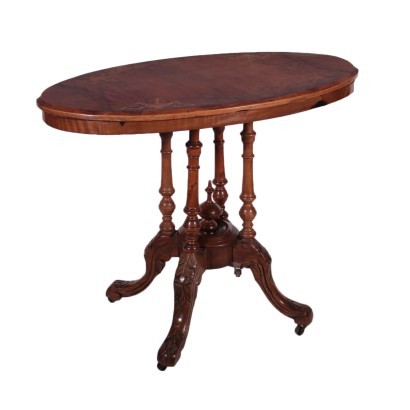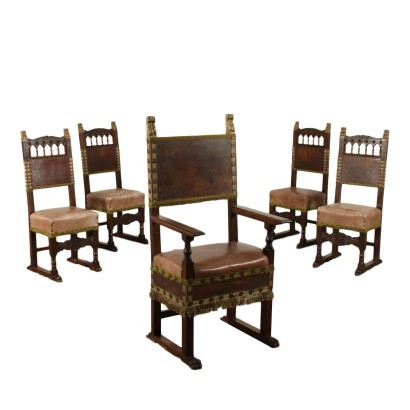Victorian coffee table
Features
Style: Victorian (1830-1900)
Age: 19th Century / 1801 - 1900
Origin: England
Main essence: Boxwood , Walnut , Elm
Description
Victorian coffee table, supported by four turned walnut uprights, resting on a shelf with four wavy feet, carved with leaf motifs and equipped with wheels. Oval top veneered in walnut burl decorated with phytomorphic inlays in boxwood. It has undergone changes.
Product Condition:
Product in fair condition showing some signs of wear.
Dimensions (cm):
Height: 70,5
Width: 87
Depth: 51
Additional Information
Style: Victorian (1830-1900)
This refers to one of the predominant styles used during the Victorian era.Like the latter, it roughly refers to the duration of the reign of Queen Victoria (20 June 1837 - 22 January 1901), from which it took its name.
Characterized by a great expansion of the home furnishing market and by new mechanized production possibilities, but not by great aesthetic innovations, but by the revival of stylistic elements from various previous eras.
Find out more about the Victorian style with our insights:
Writing desk, Arthur Blain, Liverpool c. 1840
Age: 19th Century / 1801 - 1900
19th Century / 1801 - 1900Main essence:
Boxwood
With a yellowish color, it is a very compact and hard wood, of oriental origin, which is obtained from evergreen shrubs of the Buxaceae family. It is used for inlays and for all-round workings both as furniture finishes and as small objects and sculptures.Walnut
Walnut wood comes from the plant whose botanical name is juglans regia , probably originally from the East but very common in Europe. Light or dark brown in color, it is a hard wood with a beautiful grain, widely used in antique furniture. It was the main essence in Italy throughout the Renaissance and later had a good diffusion in Europe, especially in England, until the advent of mahogany. It was used for solid wood furniture and sometimes carvings and inlays, its only big limitation is that it suffers a lot from woodworm. In France it was widely used more than anything else in the provinces. In the second half of the eighteenth century its use decreased significantly because mahogany and other exotic woods were preferred.Elm
Very hard and compact wood, which comes from ulmus campestris . It is distinguished by its reddish brown color. It was mainly used for rustic furniture in France, Holland and Scandinavia. In England, however, it was also used a lot in inlay work. It could also interest you


























